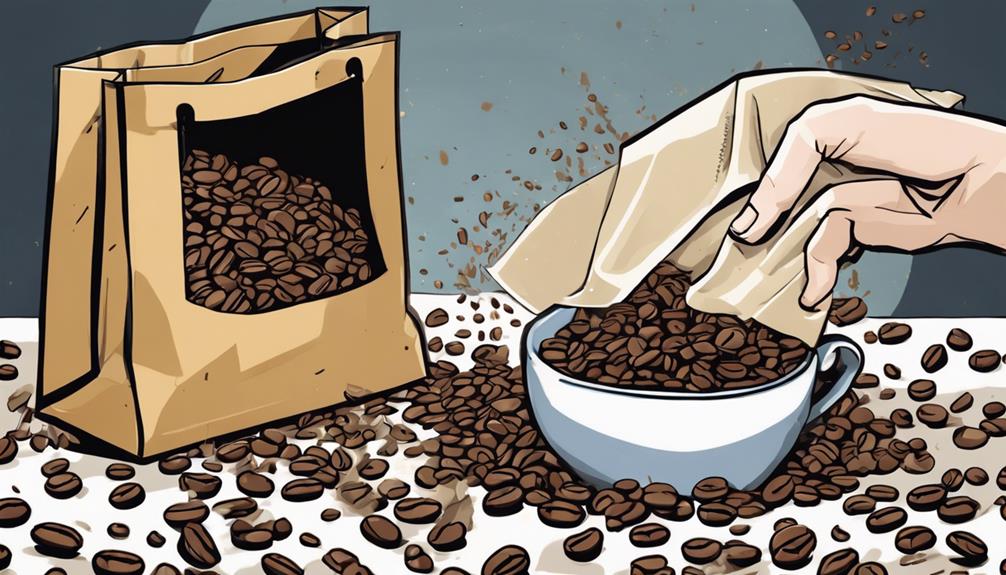Transform your lawn with coffee grounds for healthy green grass. Obtain complimentary grounds from local coffee shops, distribute them evenly, and gently rake. These grounds provide vital nutrients such as nitrogen and phosphorus, promoting the growth of your turf. Apply them on a monthly basis to ensure a dense and lively lawn. To learn more about using coffee grounds to nurture your grass, there are plenty of useful tips and insights available.
Key Takeaways
- Obtain coffee grounds from local sources for free.
- Spread grounds evenly over the lawn surface.
- Lightly rake or sweep to ensure uniform distribution.
- Reapply monthly to promote lush turf growth.
- Monitor soil acidity levels to prevent over-acidification.
Benefits of Coffee Grounds for Lawns
Coffee grounds offer your lawn a natural and eco-friendly source of essential nutrients, promoting lush and healthy grass growth. Applying coffee grounds stimulates healthy grass growth due to the nitrogen, phosphorus, and trace minerals they contain.
Unlike quick-release synthetic fertilizers, coffee grounds provide a slow release of nutrients, ensuring your grass receives a steady supply over time. Not only do your grass benefit from these nutrients, but earthworms also thrive on coffee grounds. Earthworms consume the grounds, enriching the soil with their castings and enhancing aeration, which is essential for maintaining a healthy lawn.
Applying Coffee Grounds on Lawns
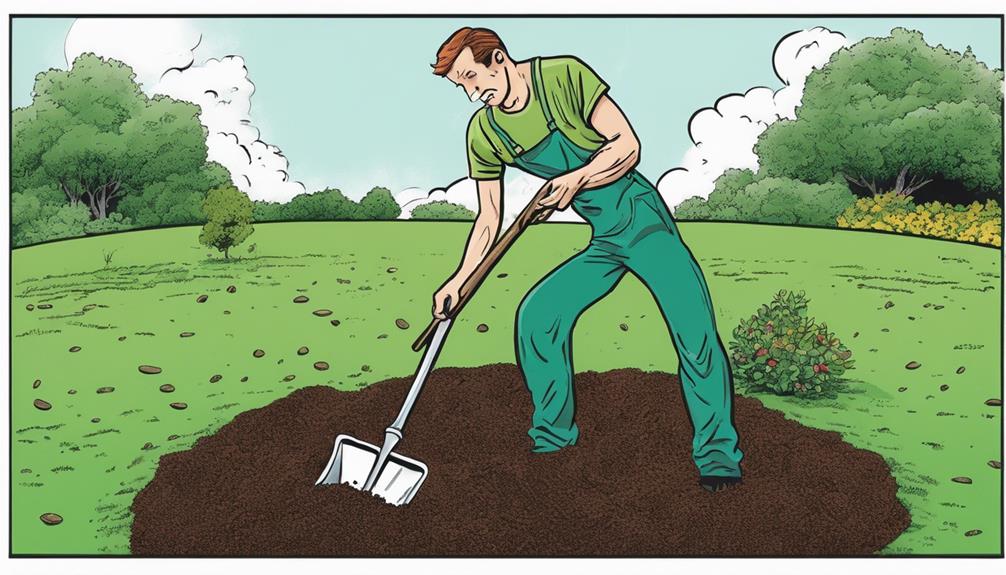
Enhancing your lawn with nutrient-rich coffee grounds involves a simple and effective application process. To begin, acquire coffee grounds from local coffee houses such as Starbucks or smaller shops that offer them at no cost. Once you have your coffee grounds, simply spread a thin layer over your lawn and lightly rake them in. Not only will this provide essential nutrients to your soil, but it will also help to improve the overall health and appearance of your grass. Additionally, you can rejuvenate your roses with coffee grounds by sprinkling them around the base of the plants to help improve their growth and bloom.
Once you have your grounds, spread them evenly across the lawn, being careful not to completely cover the grass sprigs. After spreading, lightly rake or sweep the grounds to avoid creating deep piles on the grass. For an even distribution, consider using a bucket with holes or a spreader.
Remember to reapply the coffee grounds monthly to maintain a lush and green turf. By following these steps, you can provide your lawn with a natural source of nutrients that will help improve soil health and encourage vibrant growth.
Gardening Know How Newsletter Benefits

Sign up for the Gardening Know How newsletter today to receive valuable gardening tips and a free eBook on growing delicious tomatoes.
Stay informed on the latest gardening news, promotions, and offers from trusted partners by subscribing.
Get exclusive access to a wealth of gardening knowledge and resources by joining the newsletter now.
Gardening Tips Subscription
Subscribing to the Gardening Know How newsletter offers you access to valuable gardening tips, videos, and a free eBook on growing delicious tomatoes. By signing up, you can stay informed about gardening news, receive special offers, and promotions from trusted partners. The newsletter covers a wide range of topics, including sustainable turf, lawn care, and plant remedies, providing you with insights to enhance your gardening knowledge.
When it comes to caring for your lawn, the newsletter can be a valuable resource. For instance, did you know that coffee grounds contain nutrients beneficial for your lawn? Subscribing to Gardening Know How will keep you informed about innovative practices like using coffee grounds to improve the health of your lawn.
Additionally, you'll receive exclusive content and updates straight to your inbox, ensuring you're always in the loop with the latest gardening tips and techniques.
Free Ebook Offer
Accessing the Gardening Know How newsletter grants you a free download of the eBook 'How to Grow Delicious Tomatoes,' along with gardening tips and videos. Subscribing to the newsletter not only provides you with valuable gardening insights but also keeps you updated on the latest news, offers, and promotions from trusted partners.
The free eBook offer enhances your gardening knowledge and offers practical advice on growing delicious tomatoes.
In addition to the eBook, the newsletter covers a wide range of topics, including sustainable turf, lawn care, and plant remedies to help you achieve a lush lawn. By signing up and submitting your information, you agree to the Terms & Conditions and Privacy Policy of Gardening Know How, ensuring a secure and informative gardening experience.
Don't miss out on this opportunity to receive expert advice and stay informed about gardening practices. Subscribe to the Gardening Know How newsletter today to access the free eBook offer and elevate your gardening skills.
Sustainable Lawn Care Tips
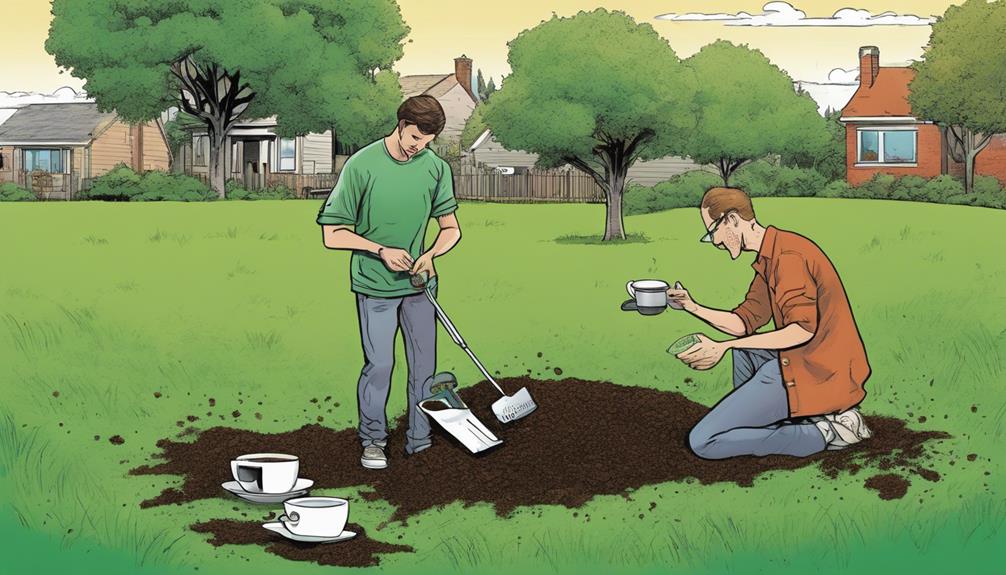
To maintain an eco-friendly lawn, consider implementing sustainable lawn care tips that promote natural practices for healthy turf growth. Utilizing coffee grounds as a natural fertilizer can enhance soil health and promote lush grass growth. Instead of discarding coffee grounds, add them to your compost pile to create nutrient-rich soil for your lawn.
Sustainable turf species that require less water and chemicals can notably reduce environmental impact while still providing a vibrant green space. Incorporating composting and mulching into your lawn care routine helps nourish the soil and supports a healthier ecosystem.
Understanding how frost affects grass seed is essential for protecting new turf during colder months. Opting for manual push mowers over gas-powered ones is a sustainable choice that benefits both the environment and your lawn's health.
Lawn Care Maintenance Tips
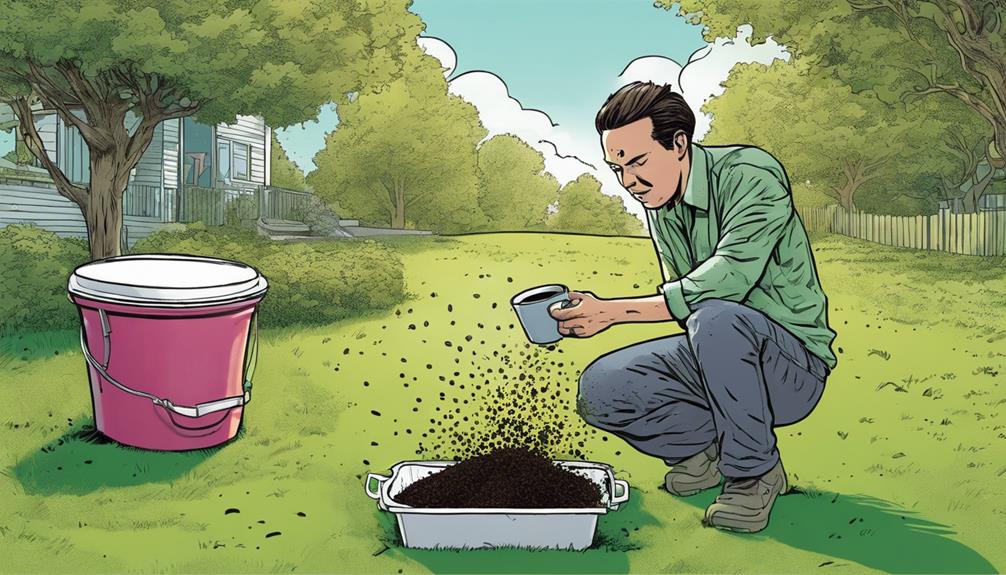
You can achieve professional-looking stripes on your lawn by mastering proper mowing techniques and using the right equipment.
Don't forget to follow a late summer lawn care checklist to guarantee your grass stays healthy and vibrant for the upcoming spring.
Consider the benefits of incorporating native evergreen shrubs into your landscaping for a sustainable and visually appealing yard.
Mowing Techniques for Stripes
Consider incorporating a striping kit or roller attachment on your mower to achieve professional-looking stripes in your lawn. To create those impeccable stripes, mow in alternating directions. This technique bends the grass blades in different ways, resulting in the classic striped appearance.
Remember, regular mowing is essential to maintain the crispness of the stripes, so keep those blades sharp!
If you want to experiment with different patterns, try mowing in checkerboard or diagonal stripes. These variations can add visual interest to your lawn and showcase your mowing skills. To enhance the striping effect, consider using a striping kit or roller attachment. These tools help define the stripes and give your lawn that polished look.
Before mowing, make sure to rake or sweep any debris from the lawn surface. Once that's done, get ready to put coffee grounds to use for a lush lawn. But for now, focus on mastering those mowing techniques to create stunning stripes in your yard.
Late Summer Checklist Essentials
As you focus on perfecting your mowing techniques for those crisp lawn stripes, now shift your attention to the late summer checklist essentials for maintaining a healthy and vibrant lawn. Late summer is a pivotal time for preparing your grass to thrive in the upcoming seasons.
Consider aerating and overseeding your lawn to promote new grass growth and address any bare spots by applying grass seed for uniformity. It's also important to apply a slow-release fertilizer during this time to provide essential nutrients to your grass.
Keeping your lawn well-watered in late summer will help it endure the stress of changing weather conditions. Remember, coffee contains beneficial nitrogen that can support healthy grass growth, making it a great addition to your lawn care routine.
Native Shrubs Landscaping Benefits
Enhancing your lawn with native shrubs offers numerous benefits for low-maintenance landscaping and promoting biodiversity. Native shrubs, requiring less water and maintenance than non-native plants, attract local wildlife and pollinators, enhancing biodiversity in the lawn. These shrubs, adapted to the local climate and soil conditions, promote healthy growth while reducing the need for chemical pesticides and fertilizers. By incorporating native shrubs, you not only add natural beauty but also enhance the overall ecological balance of your lawn.
When considering landscaping options, choose native shrubs to create a sustainable and thriving environment. By planting these shrubs, you contribute to the ecosystem's health and reduce the overall maintenance required. Native shrubs act as a natural habitat for local wildlife, supporting pollinators and beneficial insects. The use of native shrubs can also help in conserving water, creating a more environmentally friendly and beautiful landscape for your lawn.
Benefits of Using Coffee Grounds on Grass

Why are coffee grounds a beneficial choice for nurturing your grass?
Coffee grounds are rich in essential nutrients like nitrogen and trace minerals, which are crucial for promoting healthy grass growth. These nutrients support the development of strong roots, lush foliage, and vibrant colors in your lawn. Unlike quick-release synthetic fertilizers, coffee grounds release nutrients slowly over time, providing sustained nourishment for your grass.
In addition to nutrient content, coffee grounds offer various advantages for your lawn. They help suppress weed growth, enhance soil structure, and attract earthworms that aid in soil aeration.
By applying coffee grounds on your lawn, you can expect to see improvements in grass color, health, and overall turf quality. Additionally, using coffee grounds as a natural fertilizer is environmentally friendly, as it reduces water contamination and supports the growth of a lush green turf.
Embrace the benefits of coffee grounds for a healthier and more vibrant lawn today!
Effects of Coffee Grounds on Soil Acidity

Applying coffee grounds to your lawn can impact the soil acidity, potentially influencing the growth of your grass and plants. Coffee grounds possess acidic properties that can lower the pH of the soil, which may benefit certain grasses and plants that thrive in slightly acidic conditions.
However, it's essential to exercise caution as excessive application of coffee grounds can lead to over-acidification of the soil, potentially harming the growth of your grass.
To prevent negative effects on your lawn, it's recommended to conduct soil testing before incorporating coffee grounds. This will help in determining the current acidity levels and guide you in the appropriate amount of coffee grounds to apply.
Remember, moderation is key when using coffee grounds on your lawn; balanced acidity levels can offer benefits to specific plants and grasses, but excessive acidity can hinder growth.
How to Use Coffee Grounds on Your Lawn
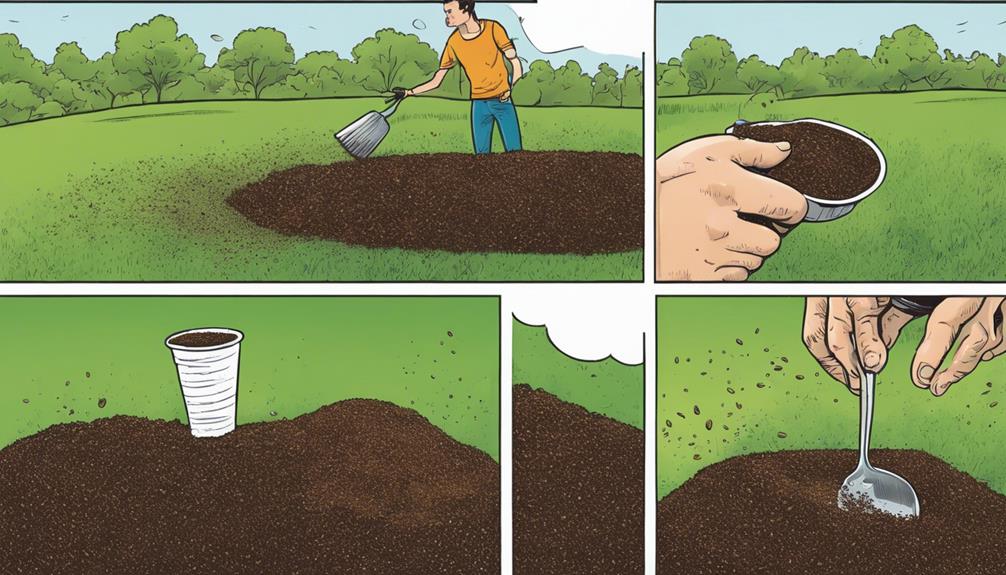
To effectively utilize coffee grounds on your lawn, start by spreading them evenly to provide essential nutrients for healthy grass growth.
Coffee grounds are a rich source of nitrogen, phosphorus, and trace minerals that can benefit your lawn.
After spreading the coffee grounds, lightly rake or sweep them to prevent clumping and guarantee better contact with the soil.
You can use a bucket with holes or a spreader to evenly distribute the grounds across the lawn.
Reapplication of coffee grounds on a monthly basis can help promote a thick, green turf and maintain soil health.
Additionally, the presence of coffee grounds can attract earthworms, which aid in soil aeration and nutrient enrichment, contributing to a healthier lawn overall.
Considerations Before Using Coffee Grounds on Grass

Before incorporating coffee grounds into your lawn care routine, it's important to weigh a few key factors for best results and grass health. Start by testing your soil to determine its existing nitrogen levels. This step is essential because excessive nitrogen application can actually harm the growth of your grass instead of helping it.
To get the most out of using coffee grounds on the lawn, consider applying them in early spring when your grass is gearing up for growth.
If you're unsure about how to proceed, don't hesitate to consult with lawn care experts or even chat with your neighbors who may have experience with this method. When you do decide to give coffee grounds a try, begin with a small amount and monitor how your lawn responds.
It's always best to start conservatively and adjust based on the feedback your grass gives you.
Additional Coffee Products for Lawn Care
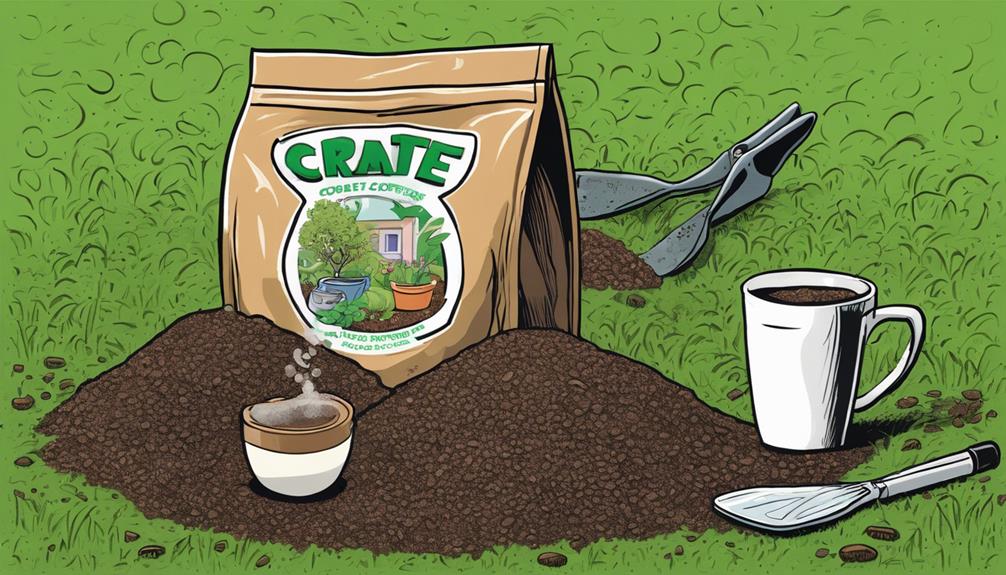
You might be surprised by the various coffee products that can benefit your lawn care routine. From high-caffeine single-serve cups to bundled sets with mugs, there are options for every coffee enthusiast.
Explore these additional coffee products to enhance your sustainable lawn care practices.
Coffee Grounds Benefits
Consider incorporating various coffee products, beyond just coffee grounds, to enhance the health and appearance of your lawn. While coffee grounds directly provide beneficial nutrients like nitrogen, phosphorus, and potassium, other coffee products can also be advantageous.
For instance, high-caffeine single-serve cups, like those offered by Black Insomnia Coffee, can provide a morning boost for both you and your lawn. Additionally, bundled coffee and mug sets not only offer convenience but can also bring a touch of novelty to your lawn care routine.
When choosing coffee products for your lawn, consider the caffeine content and blend to suit your personal preferences. Caffeine is known to stimulate healthy growth in plants, making it a valuable addition to your lawn care regimen.
Be sure to explore related articles on coffee topics for more insights on incorporating coffee grounds and products into your lawn care routine. Keep an eye out for promotions or discounts on coffee products to make your lawn care maintenance with coffee grounds both effective and cost-efficient.
Sustainable Lawn Care
Exploring beyond traditional coffee grounds, incorporating various coffee products can further enhance the sustainability of your lawn care routine. Black Insomnia Coffee's high-caffeine single-serve cups offer a morning boost, ideal for early lawn care tasks.
Bundled coffee and mug sets provide convenience and novelty, perfect for savoring while tending to your lawn. Consider the caffeine content and blend of coffee to guarantee it complements your sustainable lawn care efforts.
You can also explore related articles on coffee topics for more insights into how coffee can benefit your lawn care routine. Additionally, checking for promotions or discounts on coffee products can lead to cost-effective solutions for using coffee grounds in your lawn care regimen.
Frequently Asked Questions
How Do I Apply Coffee Grounds to My Lawn?
To apply coffee grounds to your lawn, spread them evenly using a bucket with holes or a spreader. Lightly rake the grounds for even distribution. Remember to reapply monthly for healthy grass growth, but avoid covering grass sprigs completely for best results. To avoid the growth of mold, do not apply more than a half-inch of coffee grounds at a time. Applying coffee grounds to roses is also beneficial for their growth and health. Simply sprinkle the grounds around the base of the rose bushes, and then lightly water to help the grounds seep into the soil.
Where Do You Sprinkle Coffee Grounds?
Sprinkle coffee grounds in areas where grass needs a boost. Spread them evenly to prevent clumping and enhance soil health. Mix with compost for a nutrient-rich blend. Deter pests and nourish your lawn with this simple method.
Is Used Coffee Grounds Good for Your Yard?
Yes, used coffee grounds are good for your yard! They contain beneficial nutrients for grass growth, act as a slow-release fertilizer, attract earthworms for soil health, suppress weeds, and promote eco-friendly gardening practices.
How to Make Grass Thick and Green?
To make grass thick and green, feed it well. Provide essential nutrients like nitrogen and phosphorus through coffee grounds. Spread them evenly, not in deep piles, for sustained benefits. Remember, regular reapplication guarantees a vibrant lawn.
Conclusion
So go ahead and sprinkle those coffee grounds on your lawn for a lush green paradise!
Your grass will thank you with growth so rapid, it'll make your neighbors green with envy.
Don't let those coffee grounds go to waste – put them to good use and watch your lawn thrive like never before!




